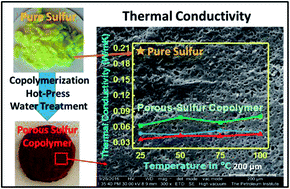Preparation and processing of porous sulfur foams having low thermal conductivity†
Abstract
Sulfur-containing polymers prepared via the inverse vulcanization technique have attracted considerable attention due to the feasibility of the method to produce stable polysulfides with up to 50–90 wt% of sulfur and their wide range of applications from Li–S batteries to catalysis, self-healing and optical materials. Despite many applications, the development of new advanced materials using sulfur is still in the initial stage. Herein, we reported the preparation and processing of a porous sulfur foam for low thermal conductivity applications by combining inverse vulcanization and template removal techniques. Initially, water-soluble template-embedded cross-linked polysulfides were prepared and hot-pressed to the required shape and size. Later, pores were generated by dissolving the template in water. The porosity of the foam was altered by varying the particle size of template materials. The effects of the templates on the porosity and morphology were discussed and correlated with thermal conductivity. The sulfur foam with a smaller pore size and high porosity showed significant decrease in the thermal conductivity up to ∼0.032 W m−1 K−1 at 25 °C, which was much lower than that of pristine sulfur (0.205 W m−1 K−1). The present method offers flexibility to modify the foam structure and properties during preparation and processing.



 Please wait while we load your content...
Please wait while we load your content...